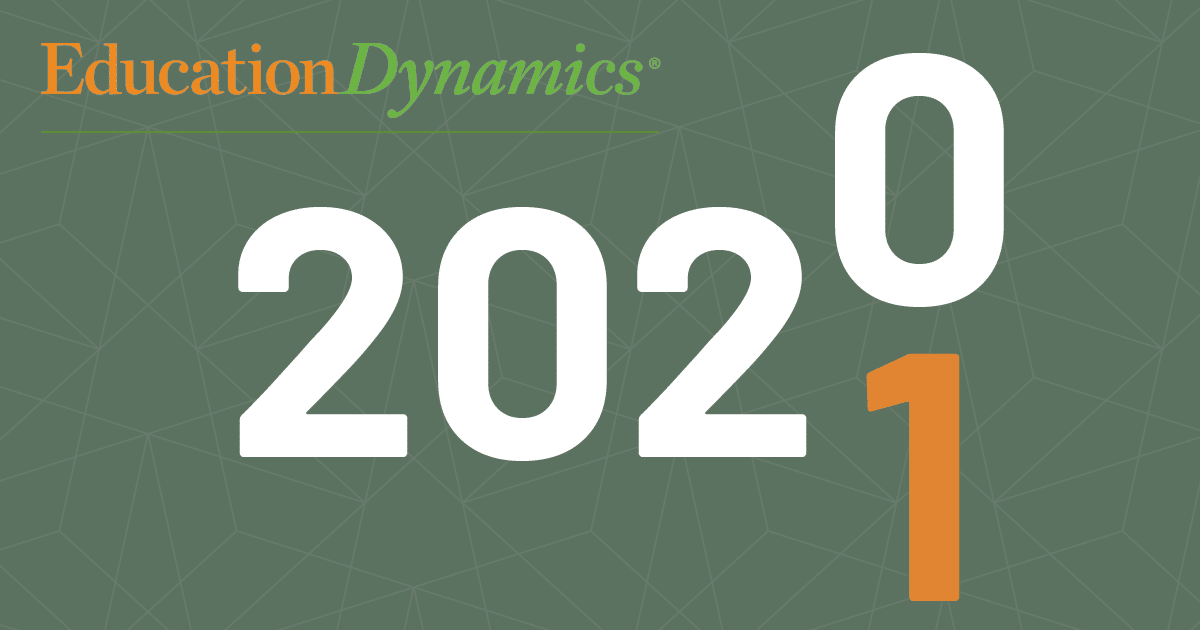Looking Back at 2020

Perspectives on the Past Year From Our CEO
We are always looking forward, focusing on what is next for higher education. As the year 2020 comes to a close, I also wanted to take a look back at the incredible year that has passed. The changes wrought by 2020 are likely to influence higher education and how we communicate with students for years to come. Looking back provides us with the opportunity to appreciate the progress we’ve made, evaluate lessons learned, and carve out our collective path forward.
First, I am most proud of how our team remained focused on the needs of the prospective students that we have the privilege to interact with, and the colleges and universities we work with. Our school partners have also done an amazing job of supporting students, including working adults, during this very challenging time.
Although the pandemic caught everyone unprepared, we were surprised and inspired by the way that most people adjusted and refocused on student needs. Even while adapting to remote work and juggling so many personal challenges, many colleges and universities have found ways to thrive. Schools succeeded when they remained focused on student needs and put the student first. They adjusted both marketing and their communication efforts to speak to student needs and concerns right now.
An Altered Landscape
The higher education landscape underwent seismic shifts in 2020. Some of these changes were short-term solutions borne out of necessity, like the closure of campuses in the middle of the spring semester and alterations to fall semester schedules. Other changes may have a more permanent and lasting impact on higher education and society in general. Here are the marketplace shifts that I think are most likely to have a lasting impact:
Much of the workforce transitioned to remote work
Stay at home orders forced a transition to remote work that caught many organizations unprepared. Despite the suddenness of this transition, many were able to accomplish it almost seamlessly. The majority of businesses and organizations discovered that remote work was a viable option for their workforces.
By August, more than a dozen major companies had announced their intention to let employees work from home long-term. It seems that workers are unlikely to return to the office anytime soon. This increased reliance on remote workers will alter the talent placement landscape, ultimately changing the way that schools connect the dots between programs and employment for their graduates.
The implications for higher education are significant. The reduction or elimination of a work commute frees up time that prospective students may spend on their education. People working from home are also more likely to become comfortable with online interactions and less likely to see a need to leave their homes for in-person classroom experiences. From a marketing and enrollment management perspective, this also impacts how and when students are likely to engage; and the modalities they choose for engagement. Will Zoom enrollment coaching sessions soon become a standard engagement strategy?
Online learning became a preferred choice
Along with the switch to remote work came a transition to online learning. The colleges and universities that thrived through this change were those that already offered online programs, but others were able to quickly put new programs into place. Into the future, working adults will continue to choose remote study for its flexibility. As a result, higher education leaders are renewing focus on this remote learning opportunity.
Schools survived and thrived by focusing on student outcomes
The schools that best survived and thrived in 2020 were those that focused their programs, marketing and communication on student needs. Job-ready skills and quick return on investment were essential, and will continue to be so into the future.
While overall, students prefer degree programs, stackable credentials are an attractive option. With them, students can see immediate results in their careers by proving competency in key areas even as they work toward a degree. The big challenge is to provide programs that deliver real value while also remaining flexible and efficient. Of course, colleges and universities must be careful to design these programs to meet financial aid requirements as well. The colleges that get this right will have a significant advantage in the marketplace.
Media consumption changed rapidly
Consumption of media and data changed more quickly than anyone could have imagined. People are spending more of their entertainment hours with online Over the Top (OTT) entertainment options. Streaming services like Hulu have seen increased engagement while traditional radio has declined as people spend less time driving. To stay relevant, enrollment marketing must go where the potential students are spending their time and money.
More time spent online also caused an uptick in organic traffic and strong inquiry rates, as our Beyond Benchmarks 2020 study reveals. SEO optimized, mobile-ready websites can help make programs more visible.
Connecting students and schools
In addition to the many external challenges we all faced in 2020, EDDY also underwent significant internal changes. Our marketing agency grew significantly, and we added to our student portal portfolio. These enhancements increased our ability to serve the full student lifecycle from consideration to graduation. We are now better able to craft and package solutions that fit our partner’s needs with bundled or a-la-carte solutions that address immediate demands and position schools for future growth.
Throughout all this, one thing hasn’t changed: Our mission of connecting schools with prospective post-traditional students still guides everything we do. We are, and will continue to be, a bridge between students and the schools that can help them achieve their academic and professional goals.
